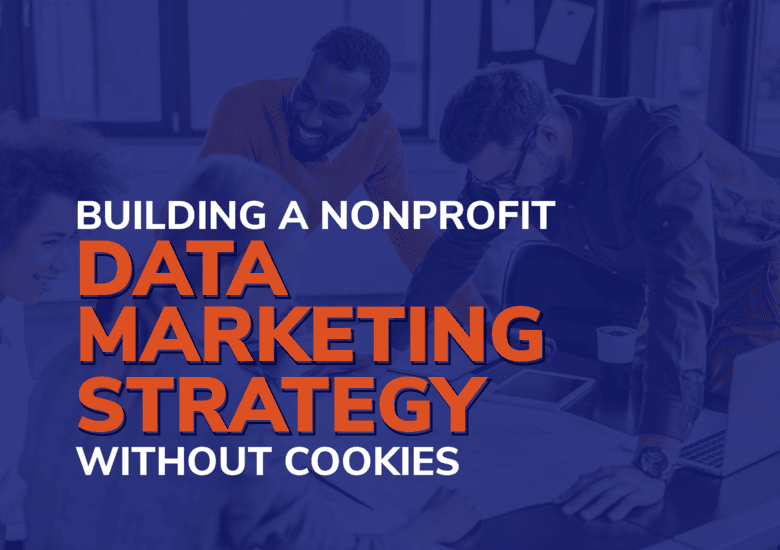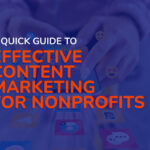Building a Nonprofit Data Marketing Strategy Without Cookies

You’ve likely seen pop-ups on your favorite websites asking if you’d like to opt into cookies. These third-party cookies allow marketers to target users based on their behavior across different sites.
As users become more concerned about data privacy, the future of third-party cookies grows increasingly unclear. While Google’s latest update seems to indicate that cookies won’t be completely phased out, they will become increasingly unreliable as more and more users opt out of them. Nonprofits still need more durable, privacy-conscious ways to incorporate data into their marketing strategies.
This guide will provide tips for how your organization can develop a robust data marketing strategy that allows you to reach your target audience and fulfill your mission without compromising supporter data privacy.
1. Focus on collecting first-party data.
First-party data refers to information supporters share through direct interactions with your nonprofit’s owned properties—namely your website, app, and/or social media accounts. Since this data comes from supporters themselves, it’s considered reliable and trustworthy.
First-party data comes in many different forms, including:
- Demographic information, like age, gender, and location
- Communication preferences
- Contact information
- Social media engagement
- Website activity
- Donation history
- Preferences and behaviors
Google’s latest third-party cookie update has left experts concerned that the company’s new consent mechanisms will cause users to reject cookies altogether. With most first-party data collection, supporters don’t have to worry about what they’re consenting to because they directly control the information they provide and understand why you’re collecting it.
Of course, that doesn’t mean first-party data strategies are automatically privacy-conscious. Deep Sync’s first-party data guide recommends following these steps to protect supporter information and remain compliant:
- Determine which regulations apply to your nonprofit. Two of the most prominent data privacy regulations are the General Data Protection Regulation (GDPR) and the California Consumer Privacy Act (CCPA). Privacy laws are constantly changing, and even if there aren’t heavy regulations in your local area, many regulations dictate that any organization collecting data from people in the area they govern is subject to compliance. For instance, any organization with supporters residing in the EU must comply with GDPR. Consult resources like the U.S. State Privacy Legislation Tracker and this global data protection heatmap to stay up to date.
- Be transparent about data collection and usage. Obtaining consent allows you to build a foundation of trust with supporters, but you should be careful to explain exactly what you’re using this information for so they can provide informed consent. For example, if a donor signs up to receive text messages from your organization, let them know you plan to send them updates on important projects, donation requests, and event registration reminders via SMS.
- Store data securely. To protect supporter information, leverage a database with advanced security features like data encryption, multi-factor authentication, and SOC 2 Type II compliance. Only provide access to team members who truly need it to limit potential fraud and mismanagement.
When you collect and use first-party data appropriately, you can make better marketing decisions, drive more meaningful donor engagement, and build stronger relationships with your supporters. Implement data hygiene practices like data entry standards, cleansing, and validation to keep your first-party data accurate and actionable.
2. Leverage data enrichment.
While first-party data is the most reliable, it might leave you with some gaps in supporter information. This issue is more common than you might think; 28% of nonprofit leaders cite not capturing the correct data as a top donor data challenge. So, how can you round out your understanding of your supporters?
Fill in database gaps with data enrichment. Data enrichment is the process of supplementing your first-party data with third-party data—information from external sources or data providers—to ensure you have a complete, accurate view of your supporters. By partnering with a trustworthy data provider, your organization can:
- Enhance its targeting based on a fuller understanding of your supporters and their needs
- Segment supporters more effectively and deliver more personalized communications
- Reduce costs by focusing on supporters who are likely to respond to your messages
- Improve supporter experiences by connecting them with relevant opportunities
- Build more meaningful supporter relationships via this deeper level of personalization
Enriching your database allows you to obtain information you may not directly request from supporters. For example, you may append income and net worth data to your database, allowing you to identify potential major donors and tailor your fundraising asks accordingly. Alternatively, you may use data enrichment to identify supporters with children and invite them to family-friendly events.
You may also leverage data enrichment to update your first-party data, such as demographics and contact information. That way, you can ensure your database is accurate without bothering supporters to update their data and conserve resources by sending marketing messages to the right people.
Since data enrichment relies on third-party data, working with a verified data provider is crucial. Research potential partners’ data privacy and collection practices, and don’t be afraid to ask about their sourcing techniques to ensure they leverage accurate, reputable external data sources.
3. Use privacy-conscious identity solutions.
You have the data you need. Now what?
Data collection is not a one-and-done process. Your supporters are constantly growing and changing, and your data marketing strategy should reflect that.
The best way to keep up with these changes is through identity resolution. Identity resolution involves combining disparate online and offline identifiers into singular supporter identities. Instead of relying on third-party cookies, this process takes the supporter data you already have, connects it to other durable identifiers, matches it to the correct supporters, and organizes it into cohesive profiles.
Not only does identity resolution allow nonprofits to get a more accurate understanding of their supporters, but it also enables them to:
- Increase supporter retention through personalized communications and interactions
- Enhance cross-channel consistency by targeting supporters with cohesive messaging across channels
- Generate a higher return on investment (ROI) by avoiding duplicate messaging and catering to supporters’ preferences and needs
For example, let’s say you want to target one-time donors and encourage them to become recurring givers. Double the Donation’s recurring giving guide recommends crafting a message that explains how recurring giving enables donors to make a sustained impact and creates a convenient giving experience. Using this messaging and supporter profiles developed through identity resolution, you can target one-time donors across online and offline channels, encouraging them to upgrade their giving with a consistent appeal.
Again, partnering with a trustworthy data provider is key. Look for a provider that takes a deterministic approach to identity resolution, meaning they use authenticated data and definitive matching to supporter profiles—rather than a probabilistic approach that relies on predictive algorithms with a wide margin of error. Additionally, your data provider should compile data from high-quality sources and follow all applicable privacy laws and regulations.
Let your third-party cookies crumble and step into the new age of data marketing with these tactics. To ensure your nonprofit data marketing strategy resonates with supporters, survey them to collect their feedback. Considered “zero-party data,” this information allows you to improve your approach and align with your audience’s preferences.


